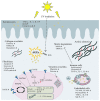Advanced glycation end products: Key players in skin aging?
- PMID: 23467327
- PMCID: PMC3583887
- DOI: 10.4161/derm.22028
Advanced glycation end products: Key players in skin aging?
Abstract
Aging is the progressive accumulation of damage to an organism over time leading to disease and death. Aging research has been very intensive in the last years aiming at characterizing the pathophysiology of aging and finding possibilities to fight age-related diseases. Various theories of aging have been proposed. In the last years advanced glycation end products (AGEs) have received particular attention in this context. AGEs are formed in high amounts in diabetes but also in the physiological organism during aging. They have been etiologically implicated in numerous diabetes- and age-related diseases. Strategies inhibiting AGE accumulation and signaling seem to possess a therapeutic potential in these pathologies. However, still little is known on the precise role of AGEs during skin aging. In this review the existing literature on AGEs and skin aging will be reviewed. In addition, existing and potential anti-AGE strategies that may be beneficial on skin aging will be discussed.
Keywords: AGEs; RAGE; advanced glycation end products; photoaging; skin aging.
Figures


References
LinkOut - more resources
Full Text Sources
Other Literature Sources
